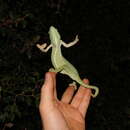Biology
(
Anglèis
)
fornì da Arkive
In common with other chameleon species, the Sahel chameleon feeds on large insects, which it catches using its remarkable, extensile tongue. The contraction of special muscles within the tongue rapidly propels it towards the prey, which is snared by a combination of the tongue's sticky mucous coating and a vacuum created by muscles in the tip (3).
The colour changing abilities of chameleons are well known, and serve multiple purposes, including social displays and indicating breeding condition (3). In this species, gravid females utilize their body colour to indicate that they are not receptive to mating, thereby preventing unwanted attention from breeding males (5).
In captivity, the Sahel chameleon lays up to 70 eggs in a single clutch, and buries them in an underground nest. However, fewer eggs are typically laid in the wild. Once the eggs hatch, the juvenile chameleons take between 12 and 16 months to reach sexual maturity (2).
Conservation
(
Anglèis
)
fornì da Arkive
The Sahel chameleon is listed on Appendix II of the Convention of International Trade in Endangered Species (CITES) and any international trade in this species is therefore strictly controlled and regulated by annual maximum export quotas (1).
The Hellenic Ornithological Society is running an ongoing project to help protect and conserve the introduced population of the Sahel chameleon in Greece, using volunteers to research and monitor this species, as well as to protect the nests (8).
Description
(
Anglèis
)
fornì da Arkive
The Sahel chameleon is one of the most common species of chameleon in Africa. While this species' usual colouration is green, with two thin, horizontal yellow bands running across the flanks, like other chameleons, it can rapidly change colour, becoming various shades of grey or yellow (2). The eyes are located on cone-shaped turrets that can swivel round independently in all directions and the head extends to the rear into a raised, bony protuberance known as a “casque”. Chameleons are remarkably well-adapted for tree climbing, with long prehensile tails and toes that are fused into opposing pads, providing a secure, pincer-like grip when moving along thin branches (2) (3)
Habitat
(
Anglèis
)
fornì da Arkive
The Sahel chameleon mainly inhabits dry forests and savannah (2).
Range
(
Anglèis
)
fornì da Arkive
Mainly distributed throughout sub-Saharan Africa, the Sahel chameleon can be found from Mali eastwards to the Horn of Africa, southwards along the west coast from Cameroon to Gabon, and northwards along the east coast from Somalia to Egypt (1). Interestingly, a population also exists in southern Greece that was introduced from Egypt (4).
Status
(
Anglèis
)
fornì da Arkive
Listed on Appendix II of CITES (1).
Threats
(
Anglèis
)
fornì da Arkive
While the main threat to the Sahel chameleon has been overexploitation for the international pet trade, it has never been one of the major exported species and therefore does not appear to be particularly at risk (1) (6). The small, introduced population in southern Greece is currently threatened by tourist development, but as it is non-native to the country, there is some controversy over whether it should be targeted for conservation action (7).

